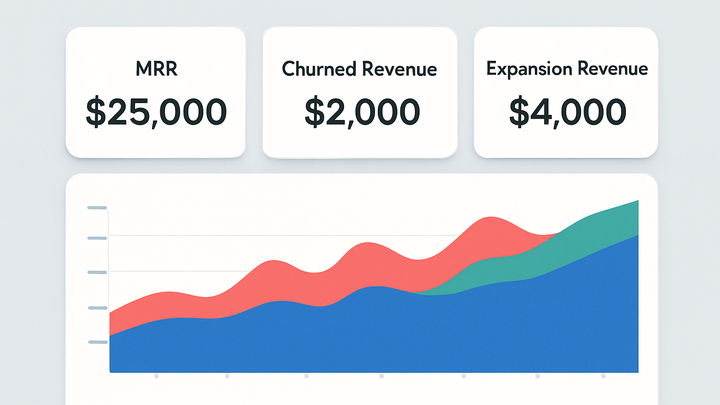Published on 2025-06-27T20:38:11Z
What is Net MRR Churn? Definition and Examples
Net MRR Churn measures the net change in Monthly Recurring Revenue (MRR) after accounting for expansions (upgrades and cross-sells) and losses (cancellations and downgrades) within a given period. It’s a critical SaaS metric that reflects the true health and growth momentum of a subscription business. Unlike Gross MRR Churn, which only tracks revenue lost, Net MRR Churn incorporates revenue expansions, making it a more comprehensive indicator of customer retention and upsell effectiveness. A positive Net MRR Churn rate signals a net decrease in revenue, while a negative rate (sometimes called Net MRR Expansion) indicates that expansions have outweighed losses. Monitoring this metric helps finance, growth, and customer success teams align strategies to minimize churn, optimize pricing, and drive sustainable growth.
Net mrr churn
Net MRR Churn is the percentage of MRR lost minus expansions, reflecting net subscription revenue change.
Definition of Net MRR Churn
Net MRR Churn quantifies how much recurring revenue your business loses after offsetting any gains from existing customers. It provides a clear picture of revenue health by combining losses from cancellations and downgrades with expansions from upgrades and cross-sells.
-
Churned mrr
The amount of MRR lost from cancellations or downgrades during the period.
-
Active cancellations
Revenue lost from customers who fully cancel their subscriptions.
-
Downgrades
Revenue lost when customers shift to a lower-priced plan.
-
-
Expansion mrr
The amount of MRR gained from existing customers upgrading or adding seats/features.
-
Upgrades
Revenue gained when customers move to higher-tier plans.
-
Cross-sells
Revenue gained by selling additional products or features.
-
-
Net mrr churn rate
Calculated as (Churned MRR – Expansion MRR) ÷ Starting MRR × 100, this rate shows net revenue loss (positive) or net expansion (negative).
-
Formula
(Churned MRR – Expansion MRR) ÷ Starting MRR × 100
-
Why Net MRR Churn Matters
Understanding Net MRR Churn helps you gauge the effectiveness of your retention and upsell strategies, forecast future revenue with greater accuracy, and identify areas of customer satisfaction or concern.
-
Growth indicator
A negative Net MRR Churn (net expansion) indicates that revenue from existing customers is growing faster than it’s lost.
-
Retention quality
Reveals whether your product delivers lasting value and whether upsell efforts are effective.
-
Forecasting
Provides a reliable input for revenue projections and budget planning by showing real net change.
How to Calculate Net MRR Churn
Follow these steps to compute Net MRR Churn accurately using your subscription data.
-
Gather mrr data
Collect starting MRR, churned MRR, and expansion MRR for the defined period from your billing system or revenue database.
-
Time period
Define the start and end dates for measurement.
-
Data sources
Ensure data accuracy by pulling directly from your billing platform or data warehouse.
-
-
Apply the formula
Use the Net MRR Churn formula to calculate the rate.
-
Calculate numerator
Subtract Expansion MRR from Churned MRR.
-
Divide by starting mrr
Divide the result by the MRR at the beginning of the period.
-
Convert to percentage
Multiply by 100 to get the percentage value.
-
-
Interpret the result
A positive percentage means net revenue loss; a negative percentage indicates net revenue gain from expansions.
Tracking Net MRR Churn with Analytics Tools
Integrate subscription events into analytics platforms like PlainSignal and Google Analytics 4 to monitor churn and expansion trends alongside user behavior.
-
PlainSignal (cookie-free)
Use PlainSignal’s event tracking to record subscription upgrades and cancellations. Add the tracking snippet to your site to begin capturing MRR-related events.
-
Install tracking code
Add the following snippet to your site’s <head> section:
<link rel="preconnect" href="//eu.plainsignal.com/" crossorigin /> <script defer data-do="yourwebsitedomain.com" data-id="0GQV1xmtzQQ" data-api="//eu.plainsignal.com" src="//cdn.plainsignal.com/plainsignal-min.js"></script> -
Define mrr events
Configure your backend or frontend to send events such as
mrr_upgradeandmrr_churnwith revenue values.
-
-
Google analytics 4 (GA4)
Leverage GA4’s event measurement and e-commerce parameters to capture subscription revenue and churn events.
-
Configure custom events
Set up events like
subscription_upgradeandsubscription_cancelin GA4 with parameters forvalueandcurrency. -
Implement gtag.js
Example code to send a cancellation event:
gtag('event', 'subscription_cancel', { value: 50, currency: 'USD' });
-
Strategies to Reduce Net MRR Churn
Adopt proactive tactics to minimize revenue loss and encourage upgrades among your existing customer base.
-
Improve onboarding
Guide new users to success quickly with tutorials, checklists, and welcome sequences.
-
Enhance customer success
Proactively engage customers through regular check-ins, health scores, and dedicated support.
-
Upselling and cross-selling
Identify customers likely to benefit from higher-tier features and launch targeted campaigns.
-
Flexible pricing plans
Offer lower-priced tiers or usage-based options to retain customers who might otherwise churn.
-
Feedback loops
Collect exit interviews and surveys to understand why customers churn and iterate rapidly.
